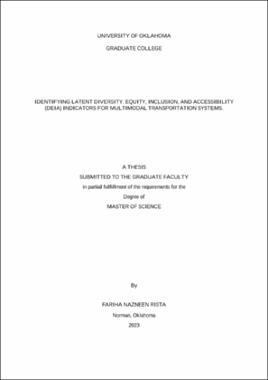| dc.description.abstract | Traditional transportation policies unfairly affect marginalized travelers and under-represented groups, limiting their access to social and economic opportunities and contributing to residential segregation. Even though there is growing acknowledgement among policymakers and planners about the need for fair and inclusive transport systems covering all modes, the empirical literature remains inconclusive and lacks sufficient intellectual tools, data sources, and standards to incorporate a system-level perspective and assess the diversity, equity, inclusion, and accessibility (DEIA) indicators for multi-modal transportation systems. Existing approaches rely on time-consuming, labor-intensive, expensive surveys that lack real-time capabilities. In contrast, this research utilizes alternative data sources such as large-scale, open-source social media and street network data to identify latent DEIA indicators for transportation systems using network science theories and advanced data-driven methods.
First, road network data from sources like OpenStreetMap or Google Maps offer a promising avenue to measure the accessibility of social opportunities for marginalized populations, such as bicycle users and transit dependents. This research aims to establish indicators of bike accessibility by utilizing open-source street network data from OpenStreetMap and extracting the bicycle network of 40 cities in the United States. Various macro network parameters (e.g., density, diameter, average path length, circuity, average degree) were calculated for the cities, along with demographic parameters obtained from the American Community Survey 2020 data (e.g., population size, per capita income, percentage of bike users). Statistical regression analysis revealed a significant relationship between accessibility score and certain network and demographic parameters. The regression model can assist planners in identifying the accessibility of the bike network in any given area using network data. The study also presents a systematic intervention method that utilizes the betweenness centrality measure to increase the accessibility of an existing network, with lower centrality nodes found to be more critical for interventions aimed at improving accessibility.
Next, social media data presents a cost-effective and real-time alternative for capturing public opinion on transportation issues, which can serve as an indicator of a transportation system's DEIA. The study leveraged approximately three months' worth of Twitter data (around 1.46 million tweets) from the state of New York to identify key transportation-related DEIA issues discussed by users. Natural language processing techniques were employed to extract transportation DEIA-relevant conversations, followed by the use of a Bidirectional Encoder Representations from Transformers (BERT) model for tweet classification. Socio-demographic information of users was detected using Random Forest machine learning algorithm. Major topics discussed by the users in the sample dataset were public transportation infrastructure, active transportation, ridesharing, accessibility, etc. Finally, a logistic regression model was developed to understand the relationship between users' demographic data and DEIA concerns. This model helps identify specific transportation DEIA issues raised by different marginalized groups, providing valuable insights for urban planners.
In conclusion, this research utilizes an innovative dataset and sophisticated data analysis techniques to introduce a unique method for assessing the diversity, equity, inclusion, and accessibility (DEIA) of transportation systems. This approach yields crucial insights for planners, pinpointing the specific locations and demographic segments most impacted by existing transportation inequities. Furthermore, the study presents a distinct strategy for systematically enhancing network accessibility. Collectively, these findings represent substantial advancements in our comprehension of, and ability to address, DEIA issues within transportation networks.
Keywords: transportation DEIA, OpenStreetMap, Graph Theory, Multiple Linear Regression model, Twitter, Machine Learning, Multinomial Logit Model, Econometric Modeling | en_US |

